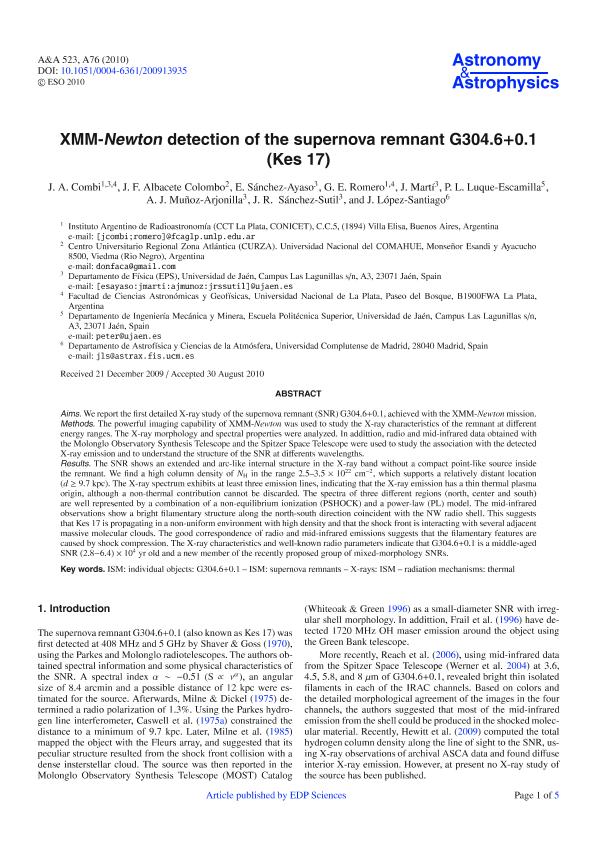Mostrar el registro sencillo del ítem
dc.contributor.author
Combi, Jorge Ariel

dc.contributor.author
Albacete Colombo, Juan Facundo

dc.contributor.author
Sánchez Ayaso, Estrella

dc.contributor.author
Romero, Gustavo Esteban

dc.contributor.author
Marti, J.
dc.contributor.author
Luque Escamilla, P. L.
dc.contributor.author
Muñoz Arjonilla, A. J.
dc.contributor.author
Sánchez Sutil, J. R.
dc.contributor.author
López Santiago, J.
dc.date.available
2017-06-26T19:57:13Z
dc.date.issued
2010-09-13
dc.identifier.citation
Combi, Jorge Ariel; Albacete Colombo, Juan Facundo; Sánchez Ayaso, Estrella; Romero, Gustavo Esteban; Marti, J.; et al.; XMM-Newton detection of the supernova remnant G304.6+0.1 (Kes 17); Edp Sciences; Astronomy And Astrophysics; 523; 13-9-2010; 76-80
dc.identifier.issn
0004-6361
dc.identifier.uri
http://hdl.handle.net/11336/18905
dc.description.abstract
Aims. We report the first detailed X-ray study of the supernova remnant (SNR) G304.6+0.1, achieved with the XMM-Newton mission. Methods. The powerful imaging capability of XMM-Newton was used to study the X-ray characteristics of the remnant at different energy ranges. The X-ray morphology and spectral properties were analyzed. In addittion, radio and mid-infrared data obtained with the Molonglo Observatory Synthesis Telescope and the Spitzer Space Telescope were used to study the association with the detected
X-ray emission and to understand the structure of the SNR at differents wavelengths. Results. The SNR shows an extended and arc-like internal structure in the X-ray band without a compact point-like source inside the remnant. We find a high column density of NH in the range 2.5–3.5 × 1022 cm−2, which supports a relatively distant location (d ≥ 9.7 kpc). The X-ray spectrum exhibits at least three emission lines, indicating that the X-ray emission has a thin thermal plasma origin, although a non-thermal contribution cannot be discarded. The spectra of three different regions (north, center and south) are well represented by a combination of a non-equilibrium ionization (PSHOCK) and a power-law (PL) model. The mid-infrared
observations show a bright filamentary structure along the north-south direction coincident with the NW radio shell. This suggests that Kes 17 is propagating in a non-uniform environment with high density and that the shock front is interacting with several adjacent massive molecular clouds. The good correspondence of radio and mid-infrared emissions suggests that the filamentary features are caused by shock compression. The X-ray characteristics and well-known radio parameters indicate that G304.6+0.1 is a middle-aged SNR (2.8−6.4) × 104 yr old and a new member of the recently proposed group of mixed-morphology SNRs.
dc.format
application/pdf
dc.language.iso
eng
dc.publisher
Edp Sciences

dc.rights
info:eu-repo/semantics/openAccess
dc.rights.uri
https://creativecommons.org/licenses/by-nc-sa/2.5/ar/
dc.subject
Ism: Individual Objects: G304.6+0.1
dc.subject
Ism: Supernova Remnants
dc.subject
X-Rays: Ism
dc.subject
Radiation Mechanisms: Thermal
dc.subject.classification
Astronomía

dc.subject.classification
Ciencias Físicas

dc.subject.classification
CIENCIAS NATURALES Y EXACTAS

dc.title
XMM-Newton detection of the supernova remnant G304.6+0.1 (Kes 17)
dc.type
info:eu-repo/semantics/article
dc.type
info:ar-repo/semantics/artículo
dc.type
info:eu-repo/semantics/publishedVersion
dc.date.updated
2016-06-15T19:20:52Z
dc.journal.volume
523
dc.journal.pagination
76-80
dc.journal.pais
Francia

dc.journal.ciudad
Paris
dc.description.fil
Fil: Combi, Jorge Ariel. Consejo Nacional de Investigaciones Científicas y Técnicas. Centro Científico Tecnológico la Plata. Instituto Argentino de Radioastronomia (i); Argentina. Universidad de Jaén; España. Universidad Nacional de la Plata. Facultad de Ciencias Astronómicas y Geofísicas; Argentina
dc.description.fil
Fil: Albacete Colombo, Juan Facundo. Universidad Nacional del Comahue; Argentina
dc.description.fil
Fil: Sánchez Ayaso, Estrella. Universidad de Jaén; España
dc.description.fil
Fil: Romero, Gustavo Esteban. Provincia de Buenos Aires. Gobernación. Comision de Investigaciones Científicas. Instituto Argentino de Radioastronomía. Consejo Nacional de Investigaciones Científicas y Técnicas. Centro Científico Tecnológico Conicet - La Plata. Instituto Argentino de Radioastronomia; Argentina. Universidad Nacional de La Plata. Facultad de Ciencias Astronómicas y Geofísicas; Argentina
dc.description.fil
Fil: Marti, J.. Universidad de Jaén; España
dc.description.fil
Fil: Luque Escamilla, P. L.. Escuela Politécnica Superior, Universidad de Jaén. Departamento de Ingeniería Mecánica y Minera; España
dc.description.fil
Fil: Muñoz Arjonilla, A. J.. Escuela Politécnica Superior, Universidad de Jaén. Departamento de Ingeniería Mecánica y Minera; España
dc.description.fil
Fil: Sánchez Sutil, J. R.. Escuela Politécnica Superior, Universidad de Jaén. Departamento de Ingeniería Mecánica y Minera; España
dc.description.fil
Fil: López Santiago, J.. Universidad Complutense de Madrid. Departamento de Astrofísica y Ciencias de la Atmósfera; España
dc.journal.title
Astronomy And Astrophysics

dc.relation.alternativeid
info:eu-repo/semantics/altIdentifier/url/http://adsabs.harvard.edu/cgi-bin/nph-data_query?bibcode=2010A%26A...523A..76C&db_key=AST&link_type=ABSTRACT&high=4cf3bad8a512265
dc.relation.alternativeid
info:eu-repo/semantics/altIdentifier/doi/http://dx.doi.org/10.1051/0004-6361/200913935
dc.relation.alternativeid
info:eu-repo/semantics/altIdentifier/url/https://www.aanda.org/articles/aa/abs/2010/15/aa13935-09/aa13935-09.html
Archivos asociados
